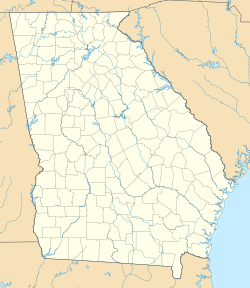Colonsay Plantation facts for kids
Quick facts for kids |
|
|
Colonsay Plantation
|
|
| Nearest city | Crawfordville, Georgia |
|---|---|
| Area | 540 acres (220 ha) |
| Built | 1789 |
| Architect | Mendenhall, Marmaduke |
| NRHP reference No. | 74000703 |
| Added to NRHP | November 21, 1974 |
The Colonsay Plantation is a very old piece of land in Georgia. It was one of the first areas given out when Georgia was still a colony of Great Britain. It got its name from a Scottish island called Colonsay. The main house on the plantation was built in 1789. It's a special place because it shows us what life was like a long time ago.
History of Colonsay Plantation
The Mendenhall Family Arrives
James Mendenhall was born in Pennsylvania in 1718. He moved to North Carolina in 1762. There, he built a mill on the Deep River. This mill was close to where the Battle of Guilford Court House happened. British soldiers even camped at his mill the day before the battle in 1781.
Because of some difficult times, James Mendenhall and his family had to move again. He bought about 600 acres (2.4 km2) of land near Wrightsboro, Georgia in 1773. This land was in what is now Taliaferro County. James went to Wrightsboro with two of his sons, Phineas and Marmaduke.
Sadly, James Mendenhall died in 1782, soon after arriving. He was buried on his new land.
Building the Colonsay House
In 1784, James's son, Marmaduke, inherited the 600 acres (2.4 km2) of land. It was almost a perfect square. The land followed the Little River and Williams Creek.
Between 1789 and 1790, Marmaduke built a large house. It was likely meant to be an inn, a trading post, and a stop for stagecoaches. It was on the road between Washington and Wrightsboro.
The house had two stories. Each story had one big room, about 20 by 20 feet. There was a chimney inside. Next to the chimney, there was a cupboard and a narrow, winding staircase. This staircase was quite unusual. It made a complete semicircle about eight feet up. Another circular staircase above it led to the attic.
The roof sloped low over the attic staircase, so you had to crawl to get into the attic. All the wooden beams inside were shaped by hand. The parts of the house were joined together with wooden pegs, showing old building methods. Both rooms were covered with wide boards of old pine wood. The wood was dark brown and looked very old.
The Colonsay Plantation house is still standing today. It is owned by Ian Mcfie. Before him, his father, Girdwood Mcfie, owned the home and 540 acres (2.2 km2) of the original land. Girdwood kept the same number of farm animals as Marmaduke had in 1797.



